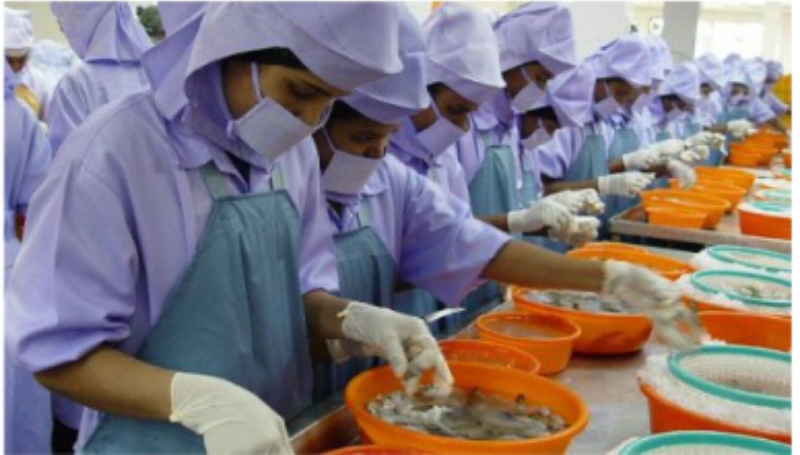The Cold Chain Industry of India is comprised mainly of small and medium size players. Very recently with the consolidation and systematization of the industry, large corporate companies have begun to invest in the Indian cold chain Industry. India has taken a major stand in the Global Seafood market and our seafood is one of the biggest foreign exchange earners and also a major employment generator. Every year thousands of acres of land are being added for aqua farming, especially for cultured shrimps. The industry generates massive employment opportunities, as it is highly labour oriented. Today, we have world class organised cold stores in every major costal belt, covering all major ports of India, following quality control procedures, meeting the most stringent of international standards.
Rising demand for Indian sea food in the global market:
India has shown the rise in trade of frozen food and seafood products. The demand for seafood continues to increase globally, and the significant population growth in China, India and Brazil constitutes the reason behind increased demand. Increase in demand for seafood has led to a rise in its imports and exports among countries, which require cold storage and refrigerated transportation. The European Union (EU) was the largest importer of seafood, importing worth $ 34 billion. In seafood import, the EU was followed by the US and Japan, in which the US imported products worth $24 billion in 2017. Over 175 processing facilities have received European Union Approval from the existing 400 processing facilities, in India. The factories are located in 20 clusters, along the East and West Coast of India.
The Seafood Exporters Association of India (SEAI) is aggressively taking initiative to develop these clusters into international seafood processing hubs. The SEAI is focused on providing better technology, food safety assurance, logistics and marketing to create a competitive edge for the Indian market. SEAI is on the lookout for establishing various infrastructure facilities in various costal states, such as landing centres, water treatment plants, common effluent treatment plants and cold store facility etc.
Importance of cold chain management:
The cold chain management is crucial in the seafood industry. It emphasizes the importance of maintaining an unbroken cold environment from the point of harvest to the consumer, to ensure optimum freshness and quality. Various studies conducted by the seafood experts confirm that early chilling is essential to maintaining the quality and shelf life of seafood. Bacteria growth begins immediately after harvest, multiplying rapidly at temperatures above 40 Degree Fahrenheit-affecting taste, colour and odour. Chilling shrimps quickly at the point of harvest reduces bacterial growth to nil and it can add days of shelf life at processing and retail facilities, provided cold temperature is maintained throughout the harvesting, processing, transportation and retail cycle.
Growth of retail sea food segment:
Several cold chain service providers have started offering end-to-end integrated services to end users in cold chain management, such as inventory management, order scheduling, order forecasting, warehousing and delivery management etc. in the refrigerated warehousing market. The seafood industry will continue to provide immense scope to generate additional storage volume, as most of seafood packers are now on the fast track to produce and supply valued seafood products in convenience packs. They are doing this by adopting the latest technologies and by tapping the unexploited and under exploited domestic market. Natural and organic meat and seafood are the fastest growing segments of retail food industry. Sustained double digit annual growth in the mainstream supermarkets in India, underscores the fact that its high time exporters also focus on the burgeoning domestic market. The cold chain companies having a pan India presence become vital resources towards providing complete logistics solutions, for all seafood packers.
Government support & the way forward:
The increasing availability of frozen sea food is a sign that the attempts to upgrade India’s cold-chain transport infrastructure are paying off. The National Centre for Cold-Chain Development, a unit of the ministry of agriculture & farmers welfare, identified a number of missing links in the country’s logistics chain—the result of a sizeable shortfall in refrigerated vehicles and pack houses with cooling facilities—which prevented the transport of perishable products, over longer distances. Since then, efforts have been made to address the problem.
New product development in frozen and chilled formats in India is being supported by government and industry efforts to increase cold-chain capabilities in the country.
Government’s decision to invest $15 billion in cold-storage infrastructure, sanction 100 cold-chain projects in the near-future, and allow 100% foreign direct investment in the segment are all facilitating towards boosting the availability of frozen sea food, further.
And that’s a blessing for India’s urban consumers hard-pressed for time, and are increasingly looking for quick and easy meals. As a result, it is expected that by 2020, India’s overall processed fish market will almost double to around INR. 477.3 crores.









